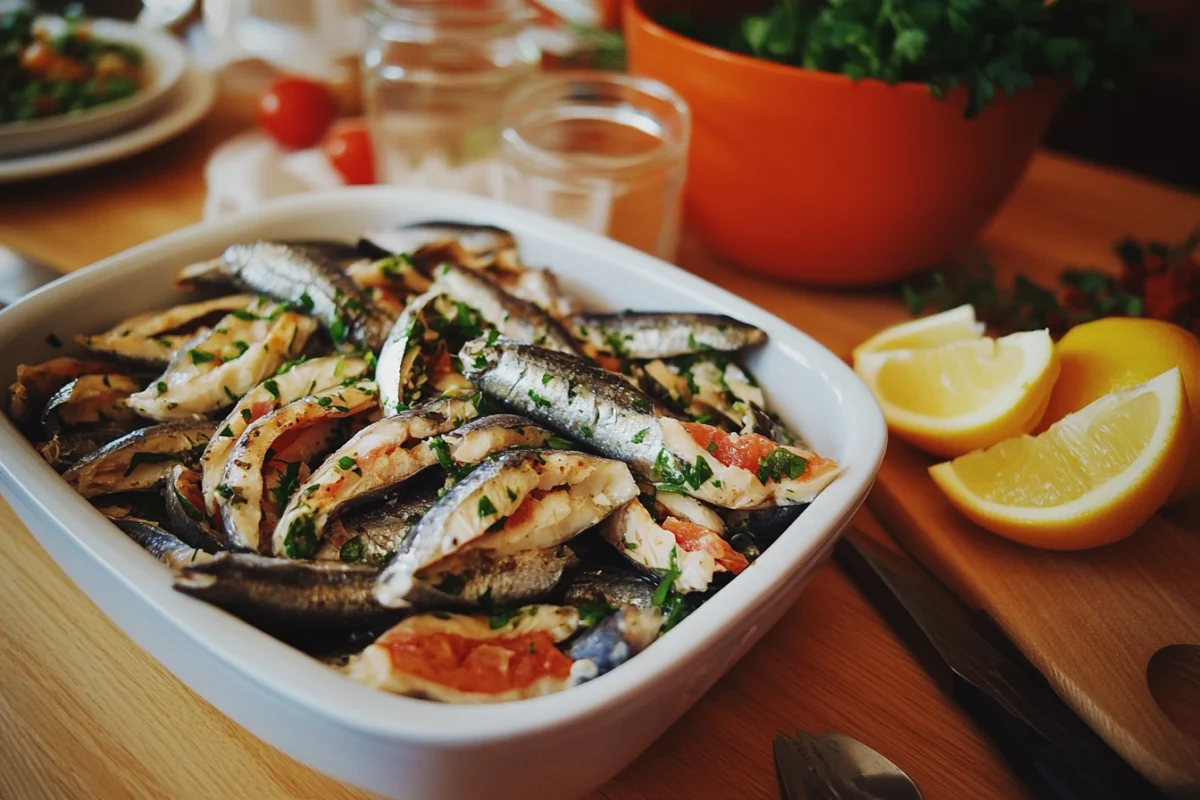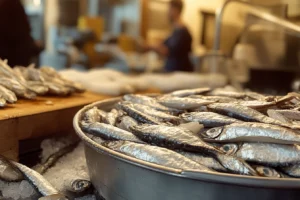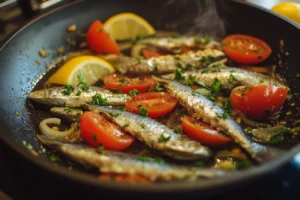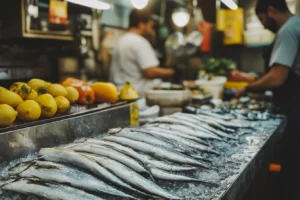Learn the clear differences between boquerones and anchovies, from flavor to preparation, and discover how these two delicacies can enrich your meals.
Boquerones and anchovies often spark curiosity in culinary circles. Many people in the United States wonder how these small fish differ and how to use them in simple yet tasty dishes. Both come from the same family, yet they offer distinct tastes, textures, and preparation methods. Understanding what’s the difference between boquerones and anchovies? helps you choose the right fish for your recipes. Whether you love Spanish tapas or crave savory Italian pasta sauces, this knowledge will enhance your cooking and dining experiences.
What Are Boquerones?
Boquerones, often called white anchovies, come from young anchovies caught near Spain’s southern coast. Fishermen pull them from the Mediterranean Sea, where these small fish thrive in mild waters. Afterward, producers clean and marinate them in vinegar and olive oil. This method helps maintain their soft flesh and fresh taste, offering a mild, tangy flavor rather than the intense saltiness found in salted anchovies.
Definition and Origin
The Spanish word “boquerón” refers to a small anchovy. Boquerones usually appear in Spanish markets and tapas bars. They became popular as an appetizer, often served with olives, bread, and a drizzle of olive oil. Spanish fishing communities have prized them for generations, treating these white anchovies as a local delicacy that reflects the region’s long maritime history.
How Producers Catch and Prepare Boquerones
Fishermen cast their nets near coastal waters, especially in warm months, to catch fresh, young anchovies. They deliver the catch to local producers who clean each fish, removing heads and intestines. Afterward, they soak the fillets in vinegar and salt for several hours. This step preserves their tender bite and bright color. Once the vinegar marinade finishes, producers rinse the fish and pack them in top-quality olive oil. This simple and careful process ensures boquerones keep their delicate flavor and mild aroma.
Common Ways to Serve Boquerones
Chefs often serve boquerones as part of a tapas spread, alongside cured ham, olives, and cheeses. They also make excellent additions to light salads or sandwiches. Their gentle flavor pairs well with ripe tomatoes, fresh herbs, and crusty bread. Because they taste mild, boquerones never overpower other ingredients. Instead, they provide a light, salty-sour note that complements many dishes. Their texture remains soft, which works beautifully in simple appetizers and refreshing snacks.
Flavor and Texture
Boquerones taste bright and fresh. Unlike fully salted anchovies, they do not deliver a heavy umami punch. Instead, you taste gentle acidity from vinegar and a smooth richness from olive oil. Their texture feels tender and moist, making them easy to enjoy on their own or in simple recipes. Many people who dislike strong fish flavors appreciate boquerones’ subtle taste.
What Are Anchovies?
Anchovies refer to small, oily fish found worldwide, especially in the Mediterranean, Atlantic, and Pacific waters. They offer a much bolder flavor than boquerones. Producers usually salt and age these anchovies to concentrate their natural savoriness. This process transforms them into potent flavor boosters that enrich sauces, dressings, and many cooked dishes.
Definition and Habitat
Anchovies belong to the Engraulidae family. They often swim in large schools, making them relatively easy to catch. Many people think of anchovies as a key element of Mediterranean cuisine. In reality, they also feature in Asian sauces, Latin American dishes, and beyond. Their oily nature and bold taste let them stand out even in small amounts.
Traditional Curing Methods
Instead of marinating them in vinegar, producers cure anchovies in salt. They layer the cleaned fillets with salt and let them rest. This step removes moisture and intensifies their flavor. After this curing phase, they pack the fillets in olive oil, preserving them for months or even years. This technique creates an umami-rich ingredient with a firm yet pliable texture.
Common Uses in Cuisine
Anchovies play a key role in many classic dishes. Italian cooks add them to sauces like puttanesca or spread them on pizza for a savory kick. Caesar salad dressing famously includes anchovies, lending a salty depth that elevates the entire dish. French Provençal cuisine relies on anchovies in tapenade, while Spanish stews and soups often benefit from a few mashed anchovies. Because they taste strong and salty, chefs often use them sparingly, like a seasoning rather than a main ingredient.
Flavor and Texture
Anchovies taste complex, salty, and intense. Their curing process amplifies their natural umami notes, creating a flavor that many describe as savory and rich. Texturally, anchovies feel firmer than boquerones, yet they still yield easily when mashed or chopped. This combination of intensity and pliability makes them valuable culinary tools.
Key Differences Between Boquerones and Anchovies
What’s the difference between boquerones and anchovies? In short, it comes down to preparation, taste, and texture. While both start from the same fish family, their distinct curing methods produce contrasting results.
Species and Maturity
Boquerones come from younger anchovies, while many anchovy products use mature fish. The youth of boquerones contributes to their tenderness and delicate taste. More mature anchovies provide a richer and bolder flavor profile, well-suited for savory recipes.
Preservation Methods
Producers prepare boquerones with vinegar and oil, which keeps them light and fresh. In contrast, they salt-cure anchovies, packing them in oil only after curing. This difference explains why boquerones taste mild and bright, while anchovies taste robust and salty.
Flavor Profiles
Boquerones taste mild, tangy, and fresh. They resemble lightly pickled seafood. Anchovies taste powerfully savory, salty, and deep. Their flavors can transform basic sauces or dressings into gourmet dishes. If you want a subtle hint of the sea, choose boquerones. If you need strong, savory depth, opt for anchovies.
Appearance and Texture
Boquerones appear whitish and translucent because the vinegar removes pigments. Anchovies, however, look darker and more opaque due to the curing process. Boquerones feel soft and delicate, while anchovies feel firm and slightly chewy. This contrast affects how each ingredient performs in different recipes.
Nutritional Comparison
Both boquerones and anchovies contribute valuable nutrients to your diet. They offer lean protein and essential vitamins. Additionally, they contain minerals like calcium and iron. However, you should note differences in fat content and sodium levels.
Calories, Protein, and Fat
Both fish remain relatively low in calories, making them good choices for lean protein. Anchovies tend to contain slightly more fat due to their curing process, but much of it comes from heart-healthy oils. Boquerones often come packed in olive oil too, though their shorter curing time usually means slightly less fat absorption.
Vitamins and Minerals
These small fish contain vitamins B12 and D, which support nerve function, red blood cell formation, and bone health. They also provide calcium for strong bones and teeth. Anchovies, because of their curing, may contain more concentrated minerals. However, both options supply a good range of micronutrients.
Omega-3 Fatty Acids and Heart Health
Anchovies and boquerones both offer omega-3 fatty acids. These important fats support heart health, reduce inflammation, and may help keep cholesterol levels balanced. Many health experts recommend eating oily fish like these two at least a few times a month.
Sodium Content and Considerations
Because producers salt anchovies heavily, they contain more sodium than boquerones. If you watch your salt intake, choose boquerones or use fewer anchovies in your cooking. Boquerones, marinated in vinegar rather than large amounts of salt, often taste less salty.
Culinary Uses and Preparation Ideas
Home cooks and professional chefs enjoy using boquerones and anchovies in a wide range of dishes. While both come from the same type of fish, their flavors work best in different ways.
Traditional Spanish Tapas with Boquerones
In Spain, boquerones star in tapas bars. Serve them on toast with diced tomatoes, olives, and a drizzle of extra virgin olive oil. Add a few boquerones to a green salad or place them atop roasted peppers for a quick appetizer. Their mild flavor fits many Mediterranean ingredients, from fresh herbs to citrus zest.
Classic Italian Dishes with Anchovies
Anchovies feature strongly in Italy’s culinary traditions. Puttanesca sauce, made with tomatoes, olives, capers, and anchovies, offers a briny, savory pasta experience. Caesar salad dressing would not taste the same without anchovies. You can also mash anchovies into butter to create a spread that boosts the flavor of grilled meats or roasted vegetables.
Modern Fusion Recipes
Chefs experiment with both fish in modern fusion dishes. For example, fold boquerones into tacos with avocado and lime. Add anchovies to kimchi fried rice for a fusion of Mediterranean and Korean flavors. The possibilities remain endless. Their differences in taste and texture allow for creativity in various culinary settings.
Simple Home-Cooking Tips
For everyday cooking, keep a jar of anchovies in your pantry. Chop one or two fillets and add them to tomato sauce, salad dressings, or marinades. They dissolve easily and enrich the dish without making it “fishy.” Meanwhile, store boquerones in the fridge and toss them into salads or serve them straight from the package. Their ready-to-eat quality makes them perfect for quick snacks or simple appetizers.
Pairings with Other Foods
Both anchovies and boquerones pair well with bread, mild cheeses, fresh produce, and light wines. Try boquerones with a crisp white wine or a cold beer. Anchovies shine with robust red wines or full-bodied whites, as they can handle richer flavors.
Cultural Significance and Global Appeal
Boquerones and anchovies hold an important place in different culinary traditions. Each culture treats these fish in unique ways, adding local flair and meaning to their preparation and serving methods.
Boquerones in Spanish Culture
Spanish markets and tapas bars celebrate the fresh taste of boquerones. They symbolize Spain’s coastal bounty and the importance of simple, fresh ingredients. During local festivals, people gather to sample these delicacies. Boquerones represent the connection between the sea and the table, reflecting centuries of fishing traditions and family recipes passed down over time.
Anchovies in the Mediterranean Region
Anchovies play a key role in Mediterranean cuisines, from Italian to Greek and French dishes. In Italy, they appear in countless recipes, from pasta sauces to savory pies. Greek cooks use them to flavor dips and spreads. French cuisine includes anchovies in dishes like pissaladière, a Provençal onion tart topped with anchovies and olives. Their bold flavor captures the essence of coastal regions where salty breezes and fresh catches define daily life.
Anchovies Beyond Europe
Anchovies also appear in non-European cuisines. In parts of Asia, people add fermented anchovy paste to soups and sauces, imparting depth and complexity. Latin American dishes sometimes include anchovies for their umami boost. This global spread shows that anchovies appeal to many palates, each culture adapting their strong flavor to local ingredients.
Symbolism and Social Importance
In many coastal communities, small fish like anchovies and boquerones represent resilience and tradition. They remind people of the importance of sustainable fishing and the connection between food and family. Their presence on dining tables helps preserve culinary heritage and spark dialogues about responsible sourcing.
Restaurants and Markets
High-end restaurants increasingly value quality boquerones and anchovies. You might find them in gourmet grocery stores or specialty shops focusing on premium Mediterranean imports. Chefs celebrate their versatility and complexity, often highlighting them on tasting menus or featuring them in creative small plates.
Buying, Selecting, and Storing
Good quality ingredients make a difference in flavor and safety. Knowing how to buy and store boquerones and anchovies ensures the best possible experience.
Choosing Quality Boquerones
Look for boquerones packed in olive oil with a clean, bright appearance. They should not smell overly fishy. Instead, they should have a mild, fresh aroma. Avoid products with dull color or murky oil. High-quality boquerones often come from Spain and carry labels of origin.
Selecting Anchovies
Choose anchovies from trusted brands. Look for fillets packed in olive oil and avoid tins with dents or rust. Good anchovies appear firm and meaty, not mushy. They smell savory and rich, not sour or off-putting. You can also find salt-packed anchovies that you must rinse before using. These may taste fresher and brighter than cheap canned ones.
Storing Boquerones and Anchovies
Keep boquerones refrigerated. Consume them within a few days of opening the package. Their delicate nature means they spoil more quickly than heavily salted anchovies.
Anchovies, on the other hand, keep longer. Unopened tins or jars last for months in a cool, dark pantry. After opening, transfer leftover anchovies to a covered container and top them with olive oil. Store them in the fridge and use them within a week or two for the best flavor.
Shelf Life and Safety
Always check expiration dates. If something smells off, discard it. Freshness matters, especially for boquerones. Anchovies, because of the curing process, last longer and remain safer for extended periods. Yet, you should still trust your senses if something seems wrong.
Sustainability Considerations
When possible, look for eco-certifications or endorsements from marine conservation groups. Sustainable fishing practices protect the ocean’s balance and ensure that future generations can enjoy these fish. Responsible producers follow guidelines to avoid overfishing and maintain healthy populations.
Health Benefits and Considerations
Both boquerones and anchovies can fit into a balanced diet, offering valuable nutrients and healthy fats. Still, consider certain factors such as allergies and sodium intake.
Positive Impact of Omega-3s
Omega-3 fatty acids found in anchovies and boquerones support heart and brain health. They help reduce inflammation and may lower the risk of chronic diseases. Including these fish in your diet, even once or twice a month, can offer benefits.
Protein and Muscle Maintenance
Both fish provide lean protein necessary for muscle growth and repair. Athletes and active individuals can benefit from including these fish in their meals. Protein also helps maintain a sense of fullness, making these small fish a smart addition to salads or snacks.
Vitamins and Minerals
Vitamins B12 and D, found in both fish, play crucial roles in energy metabolism and bone health. They also deliver calcium and iron, which support strong bones and red blood cell formation. Eating small fish with edible bones (like sardines) can provide even more calcium, but boquerones and anchovies still offer trace minerals beneficial to overall well-being.
Allergies and Who Should Avoid Them
Anyone with a known fish allergy should avoid both boquerones and anchovies. Also, people following low-sodium diets may prefer boquerones over anchovies. If you experience any discomfort after eating these fish, consult a healthcare professional.
Moderation and Balance
While these fish offer health benefits, consume them in moderation. Anchovies, salted and intense, contain more sodium, so do not rely on them as a daily staple. Boquerones, though milder, still contain some salt. Balance your seafood intake with plenty of vegetables, whole grains, and fruits.
Sustainability and Responsible Sourcing
As demand grows, sustainability becomes more urgent. Paying attention to where your anchovies and boquerones come from helps protect marine ecosystems.
Overfishing Concerns
Overfishing threatens many fish populations, including those that produce boquerones and anchovies. When fleets catch too many fish at once, the species struggle to rebuild their numbers. This imbalance harms not only the fish but also the people who depend on them for livelihoods.
Certifications to Seek
Look for labels from reputable organizations like the Marine Stewardship Council (MSC). These certifications confirm that the fish come from sustainable fisheries that respect quotas and minimize bycatch. Choosing certified products supports responsible producers and encourages better fishing practices.
Supporting Local and Small Producers
Small-scale fisheries often use more sustainable methods, like line fishing or selective nets. By buying from local fishers, you support regional economies and help maintain traditional ways of life. You also gain access to fresher products and a deeper understanding of where your food comes from.
Environmental Benefits
Sustainable harvesting helps maintain the balance of marine ecosystems. Anchovies and other small fish play a vital role in ocean food webs. By choosing eco-friendly options, consumers help protect these delicate relationships, ensuring that oceans continue to provide healthy fish stocks for future generations.
Consumer Choices Matter
Even individual decisions matter. When you pick sustainably sourced boquerones or anchovies, you send a message to producers and retailers. Over time, these choices shape the market, encouraging responsible fishing and better environmental stewardship.
Frequently Asked Questions (FAQs)
Are Boquerones Sardines?
No, boquerones are not sardines. They are young anchovies prepared with vinegar and oil. Sardines belong to a different fish family. Although both are small oily fish, their flavor, texture, and culinary uses differ. Sardines often taste richer and have a firmer bite, while boquerones taste milder.
What Do Boquerones Taste Like?
Boquerones taste fresh, mild, and slightly tangy. They do not have the intense saltiness of anchovies. Instead, you detect a light vinegar note and a gentle hint of the sea. This mild flavor makes them ideal for people who want a subtle seafood taste.
Are Boquerones White Anchovies?
Yes, people often call boquerones white anchovies. The vinegar marinade lightens their flesh, giving them a pale, translucent appearance. This visual difference helps distinguish them from the darker, salt-cured anchovies. Think of boquerones as a fresh, delicate version of anchovies.
Conclusion
What’s the difference between boquerones and anchovies? In essence, it comes down to flavor, preparation, and intensity. Boquerones represent a milder, tangier take on young anchovies, offering a fresh taste perfect for tapas or light dishes. Anchovies, by contrast, go through a salty curing process that gives them a potent, umami-packed flavor. They excel in sauces, dressings, and recipes that need a bold savory kick.
Knowing these differences helps you choose the right ingredient for your culinary goals. If you want a gentle, bright seafood accent, reach for boquerones. If you crave deep, savory richness, select anchovies. Both have rich cultural histories and nutritional benefits, and both can enhance your cooking when used thoughtfully. Ultimately, exploring both options allows you to expand your flavor palette and bring authentic Mediterranean tastes into your kitchen.
To explore more diverse food options, consider checking out the corn nuggets guide, which offers variations and ways to make these tasty bites a part of your meal.




